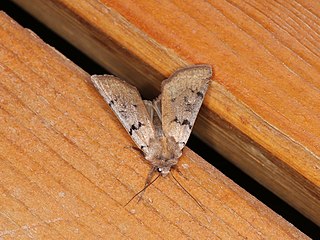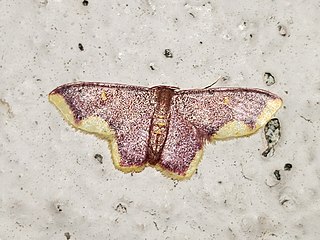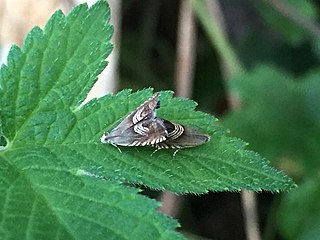
Moths are a group of insects that includes all members of the order Lepidoptera that are not butterflies. They were previously classified as suborder Heterocera, but the group is paraphyletic with respect to butterflies and neither subordinate taxa are used in modern classifications. Moths make up the vast majority of the order. There are thought to be approximately 160,000 species of moth, many of which have yet to be described. Most species of moth are nocturnal, although there are also crepuscular and diurnal species.

Lymantria dispar, also known as the gypsy moth or the spongy moth, is an Eurasian species of moth in the family Erebidae. Lymantria dispar is subdivided into several subspecies, with subspecies such as L. d. dispar and L. d. japonica being clearly identifiable without ambiguity. Lymantria dispar has been introduced to several continents and is now found in Europe, Africa, Asia, North America and South America. The polyphagous larvae live on a variety of deciduous and coniferous trees and can cause severe damage in years of mass reproduction. Due to these features, Lymantria dispar is listed among the world's 100 worst invasive alien species.

The Tortricidae are a family of moths, commonly known as tortrix moths or leafroller moths, in the order Lepidoptera. This large family has over 11,000 species described, and is the sole member of the superfamily Tortricoidea, although the genus Heliocosma is sometimes placed within this superfamily. Many of these are economically important pests. Olethreutidae is a junior synonym. The typical resting posture is with the wings folded back, producing a rather rounded profile.

Richia is a genus of moths of the family Noctuidae.

Lophosis is a monotypic geometrid moth genus. Its only species, Lophosis labeculata, the stained lophosis, is found in North America. Both the genus and species were first described by George Duryea Hulst, the genus in 1896 and the species in 1887.
Noctuini is a tribe of owlet moths in the family Noctuidae. There are at least 520 described species in Noctuini.
Caberini is a tribe of geometrid moths in the family Geometridae. There are at least 50 described species in Caberini.
Homochlodes disconventa is a species of geometrid moth in the family Geometridae. It was described by Francis Walker in 1860 and is found in North America.

Grapholita delineana, known generally as Eurasian hemp moth, is a species of tortricid moth in the family Tortricidae. Other common names include the hemp moth and hemp borer.

Metarranthis angularia, the angled metarranthis moth, is a species of moth in the family Geometridae. It was first described by William Barnes and James Halliday McDunnough in 1917 and it is found in North America.

Lithophane grotei, commonly known as Grote's pinion or Grote's sallow, is a species of moth in the family Noctuidae. It was first described by Riley in 1882 and it is found in North America.

Nemoria elfa, the cypress emerald moth, is a species of emerald in the family Geometridae. It is found in North America.

Zenophleps obscurata is a species of geometrid moth in the family Geometridae. It is endemic to North America.
Sideridis artesta, the hairy artesta moth, is a species of cutworm or dart moth in the family Noctuidae. It is found in North America.
Metarranthis pilosaria, known generally as the coastal bog metarranthi or slender groundsel moth, is a species of geometrid moth in the family Geometridae. It is found in North America.

Melipotis novanda is an owlet moth in the family Erebidae first described by Achille Guenée in 1852. It is found in North America.

Panopoda rufimargo, the red-lined panopoda, is an owlet moth in the family Erebidae. The species was first described by Jacob Hübner in 1818. It is found in North America.
Autographa labrosa is a species of looper moth in the family Noctuidae. It is found in North America.
Eupsilia cirripalea, or Franclemont's sallow, is a species of cutworm or dart moth in the family Noctuidae. It is found in North America.
Richia chortalis is a species of cutworm or dart moth in the family Noctuidae. It is found in North America.












